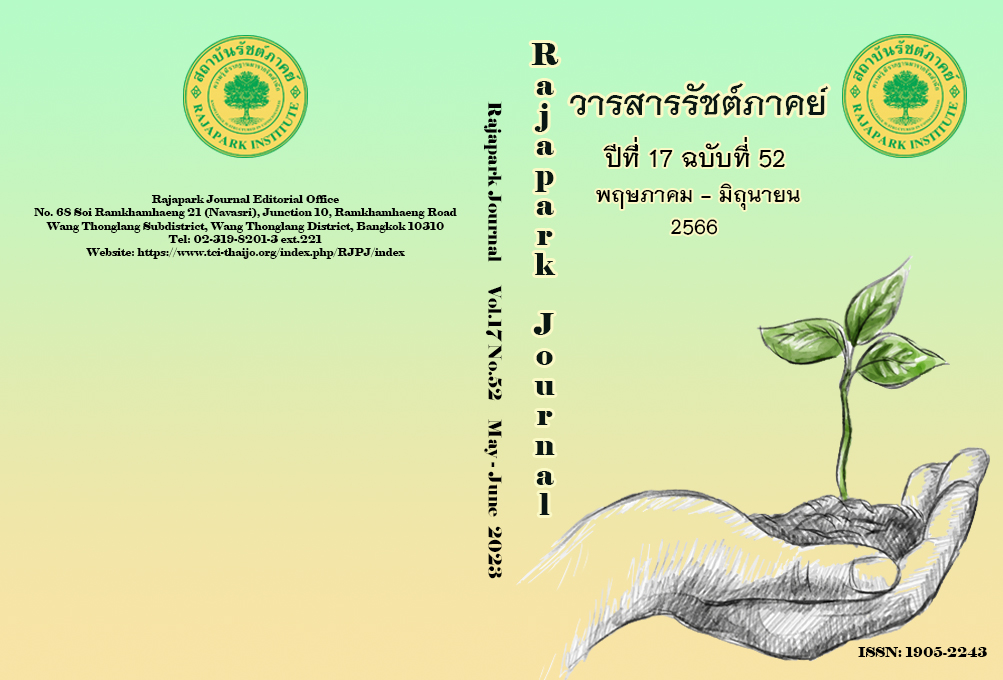Innovative Leadership Components for Team Leaders in Network Business Organizations
Main Article Content
Abstract
The purposes of this research were to (1) analyze the innovative leadership components for team leaders in network business organizations; (2) analyze the innovative leadership components for team leaders in network business organizations; (3) and evaluate the innovative leadership components for team leaders in network business organizations. This research used a mixed-method approach, divided into 3 steps: Step1: Studying components of innovative leadership for team leaders in network business through in-depth interviews with 12 senior executives Step 2: Analysis of innovative leadership components by surveying the opinions of middle management and middle group leaders by determining the size of the sample group in the hierarchy of 200 people Step 3: Evaluation of innovative leadership components by a group discussion of 10 experts to assess suitability and feasibility. The research findings showed that (1) The components of innovative leadership consisted of 4 aspects: personality, skills, roles, and social characteristics. (2) The results of the analysis consisted of 4 components: teamwork and innovative participation; innovative vision; innovative creative skills; and innovative personality. The cumulative variance was 57.840%. (3) The evaluation of the innovative leadership components revealed that all 4 components were appropriate and had theoretical possibilities. This research conclusion can be a model for other network business organizations to adapt for further work development and organizational development.
Article Details

This work is licensed under a Creative Commons Attribution-NonCommercial-NoDerivatives 4.0 International License.
Views and opinions appearing in the Journal it is the responsibility of the author of the article, and does not constitute the view and responsibility of the editorial team.
References
Adjei, D. (2013). Innovation leadership management. International Journal of ICT and Management, 1, 103-106.
Bouhali, R., Mekdad, Y., Lebsir, H., & Ferkha, L. (2015). Leadership: Communicating strategically in 21st century. Procedia-Social and behavioral Science, 155, 502-506.
Brands, R. (2010). Failure to launch: Leadership vacuums and overcoming barriers to innovation. https://www.robertsrulesofinnovation.com/2010/04 /failure-to-launch-leadership-vacuums-and-overcoming-barriers-to-innovation/
Chaiprasit, S. (2010). Innovative organization: An alternative for modern entrepreneur. Executive Journal, 30(2), 60-63.
Chamchoi, S. (2012). Concept of innovation for school management in the 21st century. Journal of Education Naresuan University, 14(2), 117-128.
Chankasem, O., Wisetsiri, W., & Pinthapat, S. (2015). The Relationship between Personal Data, Innovative Leadership of Management according to Employees’ Opinions and Employees’ Achievement Behavior in Production Industries. The Journal of Faculty of Applied Arts, King Mongkut’s of Technology North Bangkok, 8(1), 138-144.
Drew, G. (2010). Issues and challenges in higher education leadership: Engaging for change. The Australian Educational Researcher, 37(3), 57-76.
George, G., McGahan, A. M., & Prabhu, J. (2012). Innovation for inclusive growth: Towards a theoretical framework and a research agenda. Journal of Management Studies, 49(4), 661-683.
Hackman, D. G., Schmitt-Oliver, D. M., & Tracy, J. C. (2002). The standards-based administrative onternship: Putting the ISLLC standards into practice. The Scarecrow.
Horth, D. (2014). Innovation leadership: How to use innovation to lead effectively, work collaboratively, and drive results. Center for Creative Leadership.
Hunter, S. T., & Cushenbery, L. (2011). Leading for innovation: Direct and indirect influences. Advances in Developing Human Resources, 13, 248-265.
Imaginnation. (2016, March 7). 8 resons - importance of innovation to your businesses today. https://www.imaginenation.com.au/8-reasons-importance-of-innovation/
Kananurak, N. (2011). Leadership role for producing professional employees. Academic Journal of the University of the Thai Chamber of Commerce, 31(1), 123-133.
Kerlinger, F. N. (1986). Foundations of behavioral research (3rd ed.). Holt, Rinehart and Winston.
Kim, J. O., & Mueller, C. W. (1978). Factor analysis statistical methods and practical issues. Sage.
Kongjuea, K. (2011). Innovation leader. QM For Quality Management Journal, 18, 167-170.
Mavuso, M. A. (2007). Mentoring as a knowledge management tool in organization[Unpublished Master's Thesis, Stellenbosch University].
Nanthasri, T., Pengsawat, W., Chalakbang, W., & Satheannopakaow, P. (2020). Innovative leadership of school directors. Journal of Graduate School, 17(79), 11-20.
Prachankhet, O. (2014). An educational innovative organization: A new choice of educational administration. Journal of the Royal Thai Army Nurses, 15(1), 45-51.
Rotwattanaboon, O. (2010). Developing an innovative leadership model[Doctoral Dissertation, National Institute of Development Administration].
Songkhram, N. (2013). Innovating: Turning learners into innovators. Chulalongkorn University.
Srisathitnarakoon, B. (2004). The methodology in nursing research (3rd ed.). Chulalongkorn University.
Thairath Online. (2019, December 17). The Issue: "Digital disruption" is the Problem. http://www.thairath.co.th/news/business/1727105
Tirakanan, S. (2014). Social science research methodology: An approach to practice. Chulalongkorn University.
Weiss, S. D., & Legand, P. C. (2011). Innovative intelligence. John Wiley & Sons.


